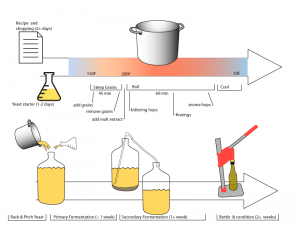“How will you grow or change as a homebrewer this Spring? How will you embrace your Spring fever and channel it toward your homebrewing endeavors?”
Byron at homebrewbeer.net poses this month’s Fermentation Friday topic. I’ve been a little busy the last w months with a new baby, but that dovetails nicely with my change. I’m working on setting up a tiered brewing system that utilizes gravity’s sweet love to move water from the hot liquor tank in to the mash tun, and that same gravity to lauter the sweet wort in to the brew kettle.
Sure, there’s the initial investment of time to build the setup, but then I’ll be able to step away from the lauter with a little more confidence to interact with the kinders during the lengthy brewing process. And the research and design process is fun.
Oh, and I’m going to start brewing 10 gallon batches. I’m now set up to do so and look forward to having doubly productive brew days.
